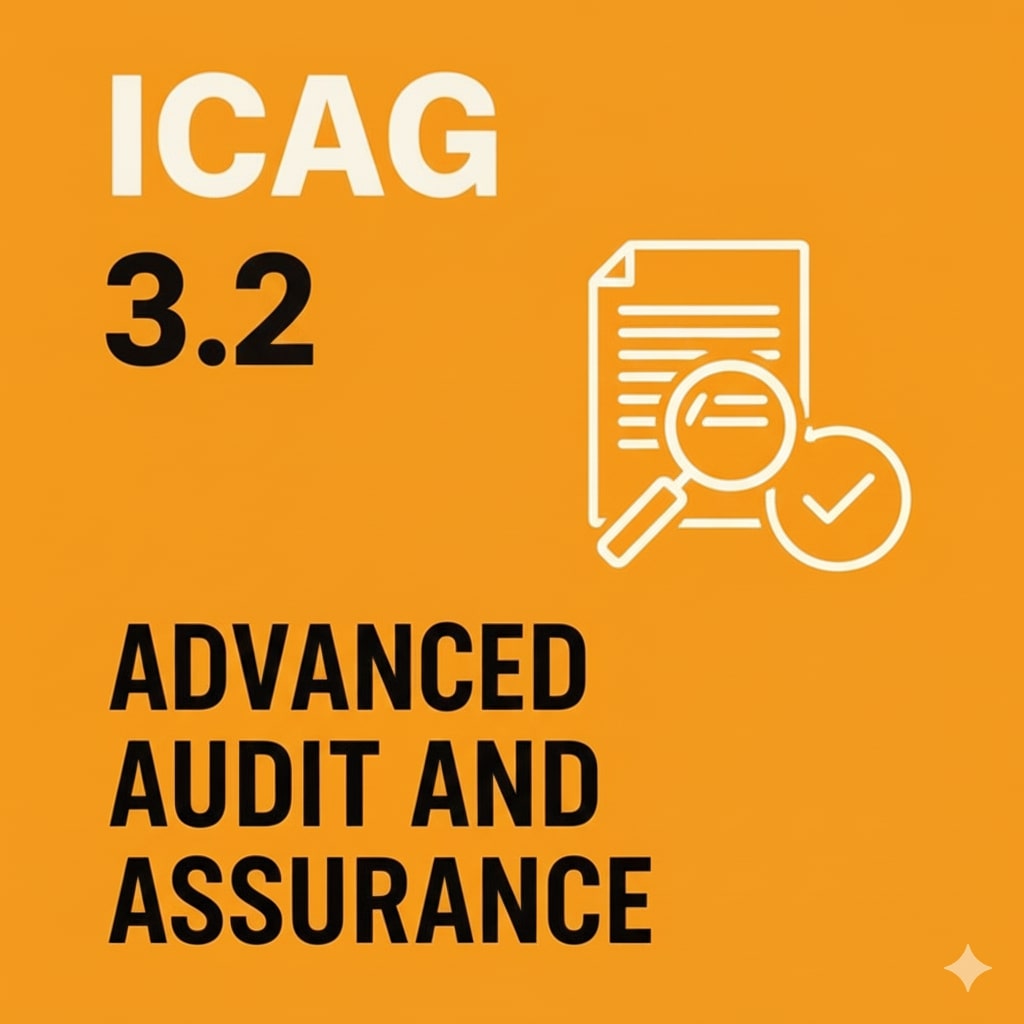The Advanced Audit and Assurance module (Paper 3.2) is part of the Professional Level (Level 3) in the ICAG professional qualification syllabus. It builds on foundational concepts from the Skills Level, focusing on providing candidates with the necessary knowledge and higher-level skills to perform the responsibilities of a registered auditor within the framework of relevant Ghanaian legislation and international standards. The module outcomes are based on the requirements of the International Standards on Auditing (ISAs) with an introduction to the International Standards of Supreme Audit Institutions (ISSAI), further developing requirements for public sector audits.
Below is the syllabus coverage in tabular form, including main topics and their approximate weightings (guiding study time and exam mark allocations).
| Syllabus Topic | Description | Weighting (%) |
|---|---|---|
| A. Nature of Audit and Assurance | Define and explain the nature of audit and assurance engagements, including the definition and components of assurance, the nature of assurance and opinions given, auditing as a component of assurance, the definition of auditing, objectives of and the need for auditing, auditing as an element of corporate governance in the private and public sectors. Explain the differences between assurance engagements and audit engagements for profit and not-for-profit entities and the public sector. Explain the basic principles of compliance audits, performance audits, and financial audits. Describe the causes of audit failure and explain the concept of the ‘audit (or expectation) gap’. Recognize responsibility for the prevention and detection of fraud. | 10 |
| B. Regulatory, Professional and Ethical Issues | Explain the purposes and consequences of laws and other regulatory requirements surrounding audit and assurance work, including the Companies Act, 2019 (Act 992) regarding qualification, appointment, remuneration, duties, rights, resignation, retirement, and dismissal of auditors; overview of International Standards on Auditing; overview of Banks and Specialised Deposit Taking Institution Act, Insurance Act, and other key acts; appointment and termination of auditors in the private sector; powers of the Bank of Ghana/National Insurance Commission; institutional regulation of audit practice by IFAC, ICAG, and Internal Audit Agency. Outline the standard-setting process used by international (IAASB) bodies and the authority of international standards. Explain the professional and IFAC ethical principles that apply for audit and assurance engagements. Identify and explain professional and ethical issues, threats, and safeguards that may arise for a specified audit or assurance engagement; explain how such issues may be mitigated; and identify when to refer such matters to senior colleagues. Apply professional scepticism and judgement in a specified situation. | 15 |
| C. Accepting and Managing Engagements | Identify and explain the factors to consider prior to accepting a specified audit or assurance engagement, including legal, professional, and ethical considerations; risk areas that may give rise to liability, such as fraud, error, and non-compliance; and terms of engagement and related documentation. | 10 |
| D. Planning for Engagements | Identify and explain, for a specified context, the nature of the audit or assurance risk environment, including the necessity to understand the business or organisation environment; identification and explanation of audit or assurance risks, including risks arising from technological developments; ways to gain an understanding of the organisation’s environment; when it may be necessary to consult an expert; implications for the audit and assurance plan; and implications for the audit or assurance engagement. Plan for an audit or assurance engagement for a specified context, including components of risks (inherent risk, control risk, detection risk); enquiries regarding fraud and errors; assessment of materiality; benefits and limitations of preliminary analytical procedures. Determine an audit or assurance approach appropriate for an engagement for a specified organisation that addresses the nature of an organisation’s internal control systems, use of internal control systems by auditors, transaction cycles (sales, purchases, employee costs), tests of control, evaluation of internal control components, communication and documentation of internal controls, reliance on experts and other auditors, and resource planning for the engagement. | 15 |
| E. Engagement Evidence | Determine the nature of evidence required for a specified audit or assurance engagement, including the nature and scope of audit and assurance evidence; use of assertions by auditors (assertions relating to Income Statement, statement of financial position, and presentation and disclosure); methods of gathering audit evidence (inspection, observation, inquiry, confirmation, recalculation, re-performance, analytical procedures); audit of specific items (tests of control for transaction cycle; substantive procedures for assets, liabilities, and equity items); sampling and other means of testing; automated audit techniques, including computer-assisted techniques, use of data analytics, and use of artificial intelligence; using the work of other auditors; and using the work of experts. | 15 |
| F. Audit Review | Explain the purpose of completion procedures, discuss when they are relevant, and illustrate the processes involved, including subsequent events, going concern evaluation, written representations, and analytical procedures at the conclusion stage. | 10 |
| G. Concluding and Reporting | Outline the procedures to conclude an assignment. Outline and explain the basic elements of an audit report. Draft a report on specified audit or assurance engagements, including communicating with those charged with governance, communicating deficiencies in internal control to those charged with governance and management, forming an opinion and reporting on financial statements, and modifications to the opinion in the independent auditor’s report. Draft extracts of a report for an audit or assurance engagement. | 10 |
| H. Internal Audit | Define and explain the role of internal audit in relation to assurance and external audit, including the definition and scope of the internal audit function; Internal Audit Agency’s role in directing public sector internal audit; internal audit and corporate governance; differences between external and internal audit functions; scope of the internal audit function; outsourcing the internal audit function; internal audit assignments and risk-based internal audit. | 5 |
| I. Auditing in the Public Sector | Identify the key differences between audits in the private and public sectors. Explain the structure and components of public sector auditing in Ghana. Explain the purpose and features of a compliance audit. Discuss the economical, efficient, and effective management of public funds and resources, particularly in public procurement (performance audit). Assess and report on the status of public financial management in accordance with the Public Expenditure and Financial Accountability (PEFA). | 10 |



